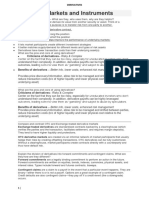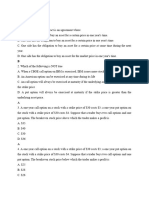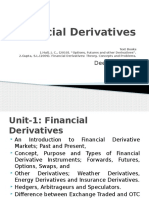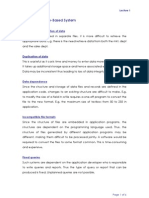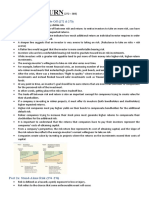Tutorial 1 - Introduction To Derivatives
Uploaded by
ne002Tutorial 1 - Introduction To Derivatives
Uploaded by
ne002TUTORIAL 1 INTRODUCTION TO DERIVATIVES
1. Which of the following best describes the nature of a forward contract? With a forward
contract, the two parties agree to: A exchange an item of a specific quality for cash at a future predetermined date. B exchange an item for an agreed amount of cash at a future predetermined date. C exchange a given amount of an item for an agreed amount of cash at a future predetermined date. D exchange a given amount of an item of a specific quality for an agreed amount of cash at a future predetermined date.
2. Which of the following correctly describes a futures contract?
A A futures is an instrument whose value depends on the values of other more basic underlying variables. B An exchange-traded contract to buy or sell a specific amount of an asset or security for a specific price or rate on a specific future date. C An agreement to buy or sell an asset at a certain time in the future for a certain price (the delivery price). D All of A, B, and C.
3. What is the economic difference between forward contracts and futures?
A There is no economic difference between forward contracts and futures. B Futures are only available on some underlying assets, whereas it is possible to trade any asset with forward contracts. C Futures contracts are traded on an exchange and have standardised terms and conditions whereas forward contracts are traded over-the-counter and have negotiated terms. D Both B and C explain the economic difference between forward and futures contracts.
4. Which of the following is correct? A swap is:
A An agreement between two counterparties to exchange two different sets of future periodic cash flows. B The spot purchase or sale of a commodity combined with the simultaneous sale or purchase of the same commodity in the forward market. C The sale of one security to purchase another. D None of A, B, or C, correctly defines a swap.
5. Which of the following is correct? The major impediment to market participants using
forward contracts is: A The reputation and credit standing of the counterparty on the other side. B The lack of counterparties willing to enter the other side of the transaction. C There are no transactions available with the right maturity. D All of A, B and C.
6. The general rule for undertaking arbitrage is this: and which means, in terms of
derivatives, a derivative instrument when its price is its theoretical or fair value price. Which of the following is correct? A buy low sell high selling above B sell low buy high buying below C buy low sell high buying below D sell low buy high selling above
You might also like
- Financial Analyst CFA Study Notes: Derivatives Level 1100% (8)Financial Analyst CFA Study Notes: Derivatives Level 133 pages
- MBA (Sem 4) Theory Examination 2019-20 Financial Derivatives Multiple Choice Questions75% (4)MBA (Sem 4) Theory Examination 2019-20 Financial Derivatives Multiple Choice Questions17 pages
- R57 Derivative Markets and Instruments - Q Bank100% (1)R57 Derivative Markets and Instruments - Q Bank12 pages
- Derivatives: 1. Before Reading The Text, Try Answering The Following QuestionsNo ratings yetDerivatives: 1. Before Reading The Text, Try Answering The Following Questions6 pages
- Short Notes From Analysis of Derivatives by Don M. ChanceNo ratings yetShort Notes From Analysis of Derivatives by Don M. Chance5 pages
- Derivative Markets and Instruments: Criticisms of DerivativesNo ratings yetDerivative Markets and Instruments: Criticisms of Derivatives10 pages
- M-410 Financial Derivatives - Answer KeyNo ratings yetM-410 Financial Derivatives - Answer Key5 pages
- Test Bank Second Term - Elmofide Without AnswersNo ratings yetTest Bank Second Term - Elmofide Without Answers18 pages
- Test Bank Second Term - Elmofide With Below AnswersNo ratings yetTest Bank Second Term - Elmofide With Below Answers22 pages
- Access Introduction to Derivatives and Risk Management Chance 9th Edition Test Bank All Chapters Immediate PDF Download100% (18)Access Introduction to Derivatives and Risk Management Chance 9th Edition Test Bank All Chapters Immediate PDF Download40 pages
- Test Bank Quản Trị Rủi Ro Tài ChínhNo ratings yetTest Bank Quản Trị Rủi Ro Tài Chính46 pages
- Chapter07 - Managing Interest Risk Using Off Balance-Sheet InstrumentsNo ratings yetChapter07 - Managing Interest Risk Using Off Balance-Sheet Instruments50 pages
- Download the PDF of Test Bank for (Chapter 1 – 26) Options Futures and Other Derivatives 10th Edition John C. Hull to read all chapters100% (2)Download the PDF of Test Bank for (Chapter 1 – 26) Options Futures and Other Derivatives 10th Edition John C. Hull to read all chapters44 pages
- First Internal Assessment - Multiple Choice Questions: Derivatives Management Maximum Marks: 50 Time Allowed: 1 HrsNo ratings yetFirst Internal Assessment - Multiple Choice Questions: Derivatives Management Maximum Marks: 50 Time Allowed: 1 Hrs5 pages
- FinQuiz - Smart Summary - Study Session 17 - Reading 57No ratings yetFinQuiz - Smart Summary - Study Session 17 - Reading 574 pages
- Reading 68 Derivative Instrument and Derivative Market Features QBNo ratings yetReading 68 Derivative Instrument and Derivative Market Features QB2 pages
- Get Solution Manual for Futures Options and Swaps 5th Edition by Kolb free all chapters100% (4)Get Solution Manual for Futures Options and Swaps 5th Edition by Kolb free all chapters42 pages
- Introduction To Derivative Markets & Instruments: - Types of Derivatives - Differences Between ExchangeNo ratings yetIntroduction To Derivative Markets & Instruments: - Types of Derivatives - Differences Between Exchange56 pages
- Financial Derivatives: W E L C O M E Financial DerivativesNo ratings yetFinancial Derivatives: W E L C O M E Financial Derivatives48 pages
- Unit III TOPIC: - Forward and Futures Contracts: Meaning, Difference Between Forward and FuturesNo ratings yetUnit III TOPIC: - Forward and Futures Contracts: Meaning, Difference Between Forward and Futures12 pages
- Submitted To Submitted By:-Mr. Amit Kumar Neha Deepak Harish Mohit KrishanNo ratings yetSubmitted To Submitted By:-Mr. Amit Kumar Neha Deepak Harish Mohit Krishan9 pages
- R58 Basics of Derivative Pricing and Valuation - Q BankNo ratings yetR58 Basics of Derivative Pricing and Valuation - Q Bank17 pages
- CFA Level 1: Derivatives and Alternative Investments: CFA level 1, #4From EverandCFA Level 1: Derivatives and Alternative Investments: CFA level 1, #45/5 (1)
- CSE 1021 - BCA - Lecture 1 - Additional NotesNo ratings yetCSE 1021 - BCA - Lecture 1 - Additional Notes6 pages
- Ch10 Financial Statements of A Limited CompanyNo ratings yetCh10 Financial Statements of A Limited Company21 pages
- Price Date Closing Price Price Log Changes Price VolatilityNo ratings yetPrice Date Closing Price Price Log Changes Price Volatility34 pages
- Culture - According To Fons Trompenaars: 1. The Universal Truth Versus The Particular InstanceNo ratings yetCulture - According To Fons Trompenaars: 1. The Universal Truth Versus The Particular Instance2 pages
- Stagflation: PDF Created With Pdffactory Pro Trial VersionNo ratings yetStagflation: PDF Created With Pdffactory Pro Trial Version2 pages
- ACC 115 - Chapter 21 Quiz - Cost Behavior and Cost-Volume-Profit AnalysisNo ratings yetACC 115 - Chapter 21 Quiz - Cost Behavior and Cost-Volume-Profit Analysis3 pages
- 2024 Topic 7 Investments (Reading Chapter 13)No ratings yet2024 Topic 7 Investments (Reading Chapter 13)28 pages
- FR - Application of Ifrs - Practice - AspireNo ratings yetFR - Application of Ifrs - Practice - Aspire28 pages
- A Project Work Report: A Study On Auto Loan Provided by Navajeevan Co-Operative Ltd. Dhangadhi, KailaliNo ratings yetA Project Work Report: A Study On Auto Loan Provided by Navajeevan Co-Operative Ltd. Dhangadhi, Kailali10 pages
- Financial - Accounting - Standards - For - Priva20151107 12826 202169 With Cover Page v2No ratings yetFinancial - Accounting - Standards - For - Priva20151107 12826 202169 With Cover Page v217 pages
- Specialization & Electives Batch 2017 & Faculty Available Timing (Spring 2020)No ratings yetSpecialization & Electives Batch 2017 & Faculty Available Timing (Spring 2020)23 pages
- Agreement of Sale - Chandu Venkata Rambabu - INo ratings yetAgreement of Sale - Chandu Venkata Rambabu - I4 pages
- Lunch With Sen. Amy Klobuchar For Follow The North Star FundNo ratings yetLunch With Sen. Amy Klobuchar For Follow The North Star Fund2 pages














